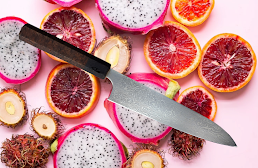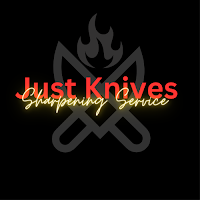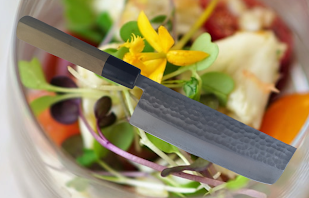5 Signs It's Time to Sharpen Your Knives
Elevating Your Cooking Experience
A chef's knife is not just a tool but a culinary extension of their arm. The precision and efficiency it offers can significantly elevate the cooking experience, transforming meal preparation from a chore into a delight. However, just like any tool, a knife's effectiveness diminishes over time with use, making sharpening not just a recommendation but a necessity. Here are five undeniable signs it's time to sharpen your knives, intertwined with insights on how a sharp knife can significantly improve your culinary endeavors.
1. The Tomato Test Fails
One of the most telltale signs your knife needs sharpening is its performance during the tomato test. A sharp knife should slice through a tomato effortlessly, with minimal pressure required, leaving behind clean, precise cuts. If your knife squashes the tomato or struggles to break the skin without excessive force, it's a clear indicator that it's time for a sharpening session. A sharp knife turns preparing delicate ingredients like tomatoes into a seamless and satisfying process, preserving the integrity and presentation of your dishes.
2. Onion Prepping Brings Tears—More Than Usual
If chopping onions feels more laborious than usual, leading to uneven cuts and an increase in tear production due to the prolonged exposure, your knife's dullness might be the culprit. A sharp knife allows for quick, clean cuts through onions, reducing cell damage and, consequently, the release of the irritating compounds that cause us to tear up. Sharpening your knife can thus make this often-dreaded task quicker and more bearable, enhancing your overall cooking experience.
3. Slicing Becomes Sawing
When the act of slicing begins to resemble a sawing motion—back and forth with considerable effort—this is a red flag that your knife is not as sharp as it should be. A properly sharpened knife glides through food with minimal effort, requiring only a simple push or pull motion. This efficiency not only saves time but also energy, making meal prep a more enjoyable and less tiresome activity.
4. Herbs are Bruised Instead of Cut
A sharp knife can beautifully chiffonade basil or finely chop parsley, enhancing the visual appeal and freshness of your dishes. However, a dull knife will bruise and crush the herbs, muddying their colors and flavors. The precision and ease a sharp knife offers when working with herbs underline its importance in preserving the integrity and vibrancy of your ingredients, a fundamental aspect of cooking that's as much about taste as it is about presentation.
5. Fear of Injury Increases
Ironically, a dull knife is more dangerous than a sharp one. When knives aren't sharp enough to cut through ingredients efficiently, it increases the risk of the knife slipping and causing injury. A sharp knife requires less force, making it more controllable and safer to use. Sharpening your knives not only enhances your culinary experience by making prep work easier and more enjoyable but also promotes a safer kitchen environment.
Embracing the Sharpening Process
Understanding these signs and responding to them by sharpening your knives can profoundly affect your cooking experience. It turns the preparation of meals into a smoother, faster, and safer process. Moreover, it allows for greater precision in your culinary creations, ensuring that each slice, dice, or chop contributes to the artistry of your dishes. A well-sharpened knife is a chef's best ally, encouraging culinary experimentation and elevating the act of cooking from mere necessity to passionate creativity. So, if you notice any of these signs, take the time to sharpen your knives. Your cooking—and your taste buds—will thank you.
What to Do About It: A Practical Guide to Regaining Your Edge
In the culinary world, a sharp knife is not just a tool; it's an extension of a chef's hand, the essential instrument that turns ingredients into creations. Known for its might and precision, a well-kept knife can make all the difference between a laborious cooking experience and a pleasurable one. But how do you maintain that keen edge once it has dulled? In this guide, we will explore practical steps to sharpen your knives and restore their pristine condition.
Recognizing the Dullness
Before you commence the sharpening process, it's essential to recognize the signs of a knife that has lost its edge. Is it crushing instead of slicing? Does it require extra effort to cut through the simplest of vegetables? If the answer is yes, then it is undoubtedly time to sharpen.
What to Do When It's Time to Sharpen Your Knives
Rally Your Tools: Gather the necessary sharpening tools such as a whetstone, honing steel, or a knife sharpener. The choice of tool will depend on how much your knife needs to be sharpened and the tools you are comfortable with.
Whetstone Sharpening:
- Soak the Stone: Submerge your whetstone in water for about 10 minutes. When no bubbles emerge, it's ready.
- Find the Angle: Hold your knife at about a 20-degree angle to the stone. This angle is typically optimal for most knives.
- Sharpen the Blade: With light pressure, glide the blade from its base to its point across the stone in a sweeping motion, ensuring you cover the entire length of the blade. Repeat this process about 5-10 times on each side or until the desired sharpness is achieved.
- Hone the Edge: Use a honing rod to straighten and refine your knife's edge after sharpening it on the stone.
- Test the Sharpness: Use the paper test or try slicing a tomato. Your knife should slice through with minimal resistance.
Honing Steel:
- Align the Steel: Place the tip of the honing steel on a stable surface.
- Maintain the Angle: Position the knife at a 20-degree angle against the steel.
- Sweeping Motion: Slide the blade down and across the steel, from heel to tip.
- Repeat: Do this several times on both sides of the blade. Hone before every use for optimal performance.
Knife Sharpener:
- Stabilize the Sharpener: Place the sharpener on a steady, flat surface.
- Insert the Blade: Place your knife in the designated slot if there are multiple options, start with the coarsest.
- Pull Through: Gently pull the knife through the sharpener, being careful not to apply excessive pressure. Repeat 3-5 times.
- Final Stage: If the sharpener has a fine sharpening slot, finish off by pulling the knife through this stage for a refined edge.
Post-Sharpening Rituals
After sharpening your knife, it's vital to perform some aftercare to ensure longevity and sustained performance.
- Inspect the Edge: Look at the blade against the light for any inconsistencies or skips in the reflection.
- Clean the Blade: Wash and dry your knife thoroughly to remove any metal shavings that resulted from the process.
- Store Properly: Use a knife block, magnetic strip, or sheaths to store your knives. Avoid throwing them in a drawer where they can get banged up.
The Final Slice
Hiring a professional knife sharpener is not just a luxury but a necessity for anyone serious about cooking, whether you are a home cook or a culinary professional. When you invest in this service, you are ensuring that your knives are honed with precision, care, and expertise. This meticulous attention to detail extends the life of your knives significantly by removing the minimal amount of metal required to restore their sharp edge, thereby preserving the integrity of the blade.
Moreover, sharp knives are crucial for cutting with precision. A sharper blade means more controlled, precise cuts, which directly enhances the quality of the food being prepared. Uniform slices cook evenly, improving the overall presentation and taste of your dishes. Adequately sharpened knives are also safer to use. Dull knives require more force to cut through food, increasing the risk of the knife slipping and causing an accident. In contrast, sharp knives do what they are supposed to do with less force and more control, vastly reducing the likelihood of injuries.
The time-saving aspect of having a professional sharpen your knives cannot be overstated. Sharpening knives is an art and a science, requiring not only specific tools but also a deep understanding of different types of blades and the angles at which they perform best. By outsourcing this task, you save the time and effort of learning and performing the sharpening process yourself.
Additionally, a professional knife sharpener can provide a finish on your knives that is difficult to achieve with at-home sharpening tools. The professional touch ensures that each edge is correctly angled and smoothly honed, which can drastically improve cutting performance. This level of precision and care guarantees your blades are in top condition, ready for any task.
In conclusion, hiring a professional knife sharpener is a wise investment for anyone who values their kitchen tools and the culinary arts. It ensures your knives receive the best possible care, saving you time and reducing the risk of accidents, all while guaranteeing a professional finish that enhances the pleasure and safety of cooking.



Comments
Post a Comment